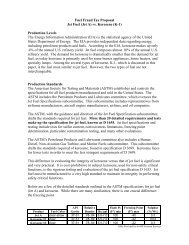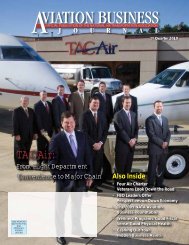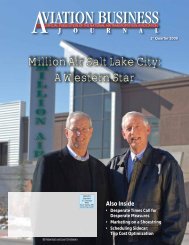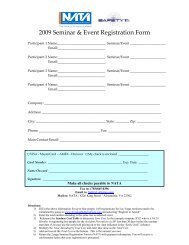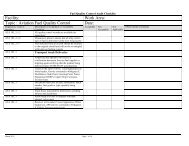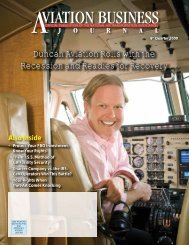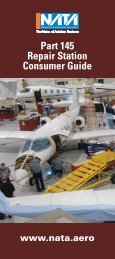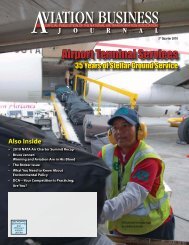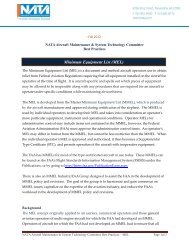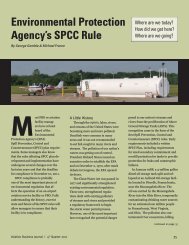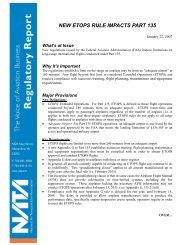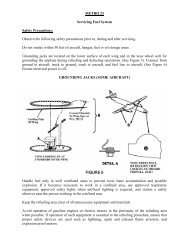Bridgeford Flying Services: A Vintage Napa Valley FBO You ... - NATA
Bridgeford Flying Services: A Vintage Napa Valley FBO You ... - NATA
Bridgeford Flying Services: A Vintage Napa Valley FBO You ... - NATA
You also want an ePaper? Increase the reach of your titles
YUMPU automatically turns print PDFs into web optimized ePapers that Google loves.
Insurance Traps to Avoid<br />
Continued from page 38<br />
standard certificate language was rejected by a foreign<br />
country. In order to get the charter out of that<br />
country, we had to get the certificate revised. Luckily,<br />
we got it resolved within about 45 minutes.”<br />
ABJ: Is war risk insurance still an issue?<br />
“The prices have come down since 2001, and if<br />
you know how to go about it, you can negotiate a<br />
higher limit. But we still see outrageous costs for a<br />
trip to Europe. We might see a charge of $5,000 or<br />
$10,000 to go to Europe. If it’s done right, in advance,<br />
it should be for much less, maybe $1,500 or<br />
something like that. The cost for unlimited travel<br />
is higher.”<br />
ABJ: It’s just because of ignorance that it’s $5,000 to $10,000?<br />
“Correct. Without prior planning, operators get into<br />
a panic. They have to go now; but, they did no planning<br />
so they have to go out in the market to buy it<br />
and the market really slams them.”<br />
ABJ: What should an operator consider when determining an<br />
insured hull value?<br />
“That’s a very good question. Aviation insurance is<br />
unique. If you purchase an airplane for $25 million<br />
and a new one coming off the line is $27 million,<br />
you can insure your current aircraft for $27 million<br />
(because you’d want to replace it with a new one.<br />
“Also, you can replace it for what you paid for it,<br />
or you can depreciate it over time. If it’s now on<br />
your books for $20 million, you could insure it for<br />
$20 million.<br />
“So, I advise the client to review their limits very<br />
carefully each year before the renewal. We advise<br />
them to look at the book value and what the<br />
replacement cost might be. Sometimes used planes<br />
go up in value, and sometimes they go down. If the<br />
hangar burned down and all you see is ashes, what<br />
would you do? Would you want a different type of<br />
airplane or the same airplane? Are there a lot of<br />
them available on the market or none available?<br />
The best bet is to try to look at that value and think<br />
it through. And the cost of hull insurance currently<br />
is very cheap.”<br />
ABJ: Why so?<br />
“There’s a lot of competition in the marketplace.<br />
Using business jets as an example, some rates are<br />
as low as 10 cents and some as high as 40 cents, so<br />
let’s just say the cost to insure is 20 cents per $100<br />
of value. <strong>You</strong>’re probably going to pay more than<br />
that for your homeowners. And your house is sitting<br />
in one place.”<br />
ABJ: <strong>You</strong> can’t replace a broker, can you?<br />
“No. <strong>You</strong> have to have some kind of a broker. I think<br />
clients need to develop partnerships with their<br />
broker and their underwriter and have long-term<br />
relationships. But each party has to pull their own<br />
weight and everybody has to work together. That’s<br />
how the client gets the best result.”<br />
ABJ: What’s the right liability limit?<br />
“I think it depends on the net worth of the owner<br />
and passengers, and a lot on the type and the size<br />
of the airplane. It also depends on where they fly.<br />
<strong>You</strong> could fly from two small towns between plants,<br />
have a turboprop, and maybe you’re an individual<br />
who owns it, and maybe $5 or $10 million dollars<br />
liability might be okay.<br />
“If you’re a corporation, you probably wouldn’t<br />
want less than $50 million; and if your aircraft is a<br />
jet and it’s got the capability of 500- to 1,000-mile<br />
range, I look at $100 million up to $500 million. If<br />
you have a GV and you’re flying executives and<br />
clients all over the world, $500 million is probably<br />
the minimum you want.<br />
“So, it’s something that you develop working with<br />
the client, finding their comfort level. Maybe $300<br />
million is enough, but the client may feel it’s really<br />
inexpensive to go to $500 million and they want<br />
that extra comfort level and their board and the<br />
shareholders to know that the corporation is properly<br />
protected.”<br />
ABJ: What should a charter operator consider from the passenger’s<br />
or client’s perspective?<br />
“<strong>You</strong> want to make sure they’re fully covered given<br />
the passengers they’re carrying.<br />
ABJ: What reimbursement can you expect for claim-related substitute<br />
aircraft expenses?<br />
“Let’s say that your GIV is damaged and you charter<br />
a GIV. Maybe you have to pay $5,000 an hour to<br />
charter that airplane. <strong>You</strong> get $5,000 an hour minus<br />
what it would have cost you for the trip in your<br />
own airplane.”<br />
ABJ: Where is aircraft-related equipment covered? What is a “spare<br />
part”? What is “moveable equipment”?<br />
“Aircraft-related equipment comprise spare parts<br />
specifically designed for installation on an aircraft,<br />
such as extra altimeters, generators, passenger<br />
seats, and APUs. These should be covered under<br />
the hull section of the aviation policy. There is<br />
also maintenance and other equipment where the<br />
aircraft is based that are not aircraft-specific such<br />
as any parts not designed for installation on that<br />
specific aircraft, for example, hydraulic power units.<br />
Examples of moveable equipment are power washers,<br />
jacks, tugs, and stairs not attached to the aircraft.<br />
These need to be covered under a property<br />
policy with inland marine coverage because most<br />
40 Aviation Business Journal | 2 nd Quarter 2008



